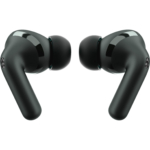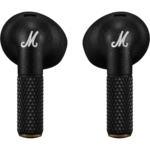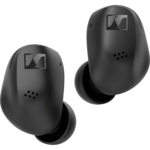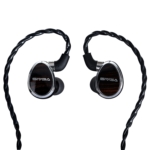The OneOdio OpenRock S are airborne sound-transmitting headphones with very good wearing comfort because your ears remain free. This is especially good if you want to stay in acoustic contact with your surroundings. The fact that the somewhat sharp high mids of the sister model OpenRock Pro have been tamed a little by the OpenRock S improved the sound image and meant they earned half a star more in our rating. Although the sound was not yet on a par with in-ears in the same price range, it still provided pleasant music listening and good voice quality during phone calls. Considering the even more favourable price compared to the Pro version, the OneOdio OpenRock S earned a well-deserved four and a half stars from us.
- High wearing comfort
- Long battery life
- Adjustable ear hooks
- Somewhat mid-range-heavy
- No volume control via the headphones
Air conduction is basically a pretty neat thing: you simply position the membranes in the immediate vicinity of your ear canal and they then deliver the sound waves via the shortest possible route. The big advantage is that you remain in acoustic contact with your environment because enough external sound still finds its way past the earphones and into your ear. As a pleasant side effect, you also have to deal with significantly less perspiration during sport than with airtight in-ears.
Where there is a lot of light (or air), there is also a lot of shadows, and of course, Air conduction – despite all the advantages mentioned – also has its disadvantages. First and foremost, these concern the sound because the fact that you are dealing with an open system means that there is nowhere near as much dynamic pressure as with in-ears, which results in a significantly lower maximum volume and noticeably less bass volume. In addition, the overall sound is less direct and impulsive than it would be from in-ears. In terms of construction, the OpenRock S are also much more expansive than in-ears. Which brings us straight to the next subject:
Handling
To wear the OpenRock S, you simply hang them over your ear so that the movable headband is behind the auricle and the membrane unit is in front of the ear canal. The headband can be adjusted at an angle of approx. 30 degrees to accommodate different ear shapes.
The size of these headphones naturally also has advantages – first and foremost, there is more space for the batteries. And so the maximum playing time per battery charge is a full 19 hours. The supplied case has a somewhat unusual but extremely practical shape similar to that of a small glasses case and holds reserve power for just under three full charges.
A full charge cycle takes around 1.5 hours, while the power reserve for an hour of listening pleasure can be pumped into the batteries in just 5 minutes. The case itself is supplied with power via a USB-C socket and provides information on the charge status via four LEDs.
For spectacle wearers, an additional earpiece over the ear is, of course, not exactly ideal – but you can still place the arms of your glasses reasonably well on the OpenRocks’ brackets, so wearing glasses doesn’t disqualify you from making a purchase. Be that as it may, it was more comfortable if I took my glasses off while listening.
Other than that, wearing comfort was certainly the decisive feature when it came to considering a purchase of the OpenRock S. Because these headphones really do nestle perfectly over the ears: once you have carefully placed them over the ear and bent them to fit, you very quickly forget that they are there at all. And it was a fundamentally different wearing experience compared to using in-ears or over-ears because you remain in acoustic contact with your surroundings – for better or worse. This was a particularly pleasant experience when making phone calls, as you can still hear yourself very well in the room.
Functions on the headphones
In contrast to the Pro version, where media and call control is carried out via buttons on the underside, the OpenRock S are operated via touch sensors on the outside of the housing. The functions available here are limited to play/pause, track navigation, call acceptance and activating the voice assistant. All functions require at least two (or more) touches – random touches don’t, on the whole, create operating errors. However, the simplest and most important function of all has fallen by the wayside: volume control. I deduct one point from the function rating for this.
Technology
The sound is converted by a dynamic 16.2-millimetre driver, from which the sound waves travel via the short air path through the inner ear to the eardrum. The frequency range covers the typical hi-fi range of 20 Hz – 20 kHz.
A2DP, AVRCP, HFP and HSP are supported as Bluetooth profiles. The audio codecs used are either aptX, AAC or SBC. Protection against environmental influences extends to IPX5. And if you have always thought that black headphones don’t suit you, the “cream” colour variant should be attractive – it is a slightly tinted, powdery old white, which for me seemed a little too orthopaedic (nothing against the blessings of orthopaedics, but you don’t necessarily want to have devices in this colour without it being a necessity).
Sound
As I already mentioned at the beginning of this review, airborne sound transducers such as those used by the OneOdio OpenRock S cannot (yet) compete with in-ears in terms of sound. The “TubeBass” technology used here, which is intended to provide a fuller bass response, does nothing to change this. In-ears simply put more pressure in at the bottom end and are more impulsive in the mid-range. However, this doesn’t necessarily make listening to music with the OpenRock S any worse – just different. In terms of sound, the OpenRock S are much more discreet, like a small microsystem that is placed somewhere in the room and provides pleasant background music. You won’t get carried away or surprised by anything here – everything tends to be in the mid-range and at a moderate volume.
As such, the two integrated EQ modes, “Rock” and “Relax”, which you can switch between by holding down the two sensor buttons, were rather superfluous. In short, “Rock”, with its uncut frequency response, simply sounded better than the “Relax” mode, which removed some of the already subtle bass.
In a direct comparison, the “OpenRock S” surprisingly sounded slightly better than the more expensive Pro version. This was mainly due to the fact that the high-mids were a little less present in the S version, which made the sound much more relaxed.
I can also report good things about the voice quality during phone calls: A total of four microphones are used for voice transmission, and these are supported by an AI algorithm that is able to (partially) suppress ambient noise. This worked quite well in practice, with the person on the other end of the line being able to be understood with a usable quality, and it even made longer conversations or video conferences pleasant for both sides. Here, too, the freedom afforded to the ears had a very positive effect – or more correctly: was not noticeable. This was because hearing your own voice in the room gives you very good control over what is being said, and the free circulation of air keeps your ears cool even during lengthy conversations.
Conclusion
OneOdio’s OpenRock S bring the concept of open-air sound transmission to the headphones market in a very successful form and at a reasonable price. If you so far have not been happy with in-ears, either because they made you feel too isolated from the environment or you simply don’t like the feeling of having something stuck in your ear, you should find a good alternative with this device. Although the sound doesn’t come close to the frequency spectrum and dynamics of in-ears in the same price range, it opens up a completely new wearing experience. And a changed perception of music because the fact that you remain in acoustic contact with the environment makes it feel much more like the music is taking place in the room rather than in your head.
Technical specifications
- Ear couplingOpen-Ear
- Typeopen
- Transducer principledynamic
- Frequency response (headphones)20 - 20.000 Hz
- Weight without cable13 g
What's in the box
- Charging cable (USB-A/C)
- Charging case
Special features
- Available in black and lite khaki
- BT version: 5.3
- BT codecs: SBC, AAC, aptX











































